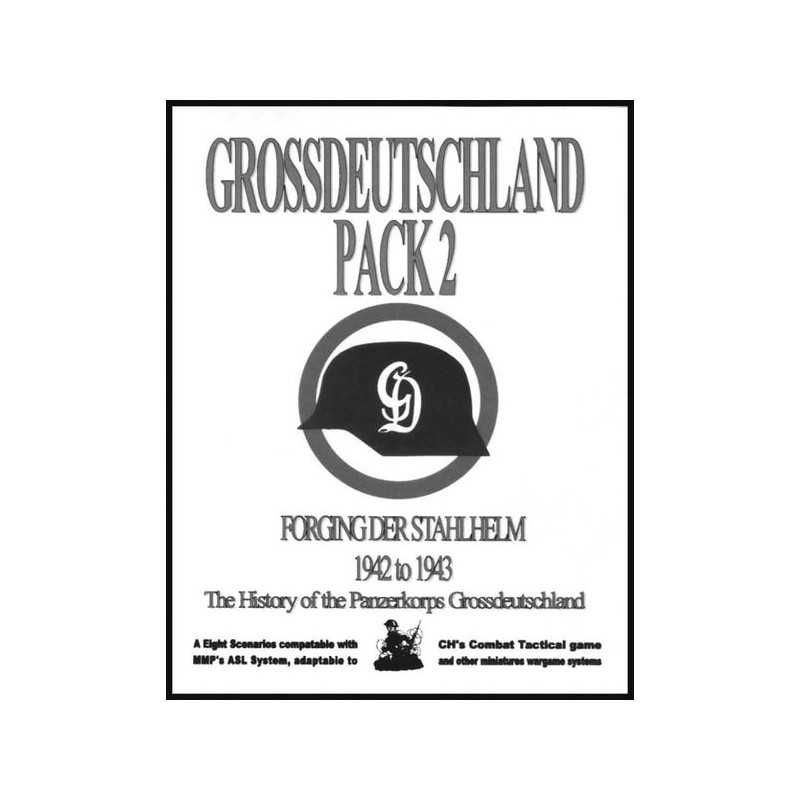- -10%




The 2nd Lone Canuck ASL scenario module for the famed German Grossdeutschland unit. These 8 scenarios cover actions on the eastern front. Ownership of Advanced Squad Leader and some of its modules required.
Out-of-Stock
 Game description
Game descriptionThe 2nd Lone Canuck ASL scenario module for the famed German Grossdeutschland unit. These 8 scenarios cover actions on the eastern front. Ownership of Advanced Squad Leader and some of its modules required.
1 July 1942... 0630-hrs Panzer Battalion Grossdeutschland had already successfully repulsed the early morning Soviet tank attack. When the 2nd Reconnaissance Squadron reached the high ground to the north of the small village of Kulewka. There it observed a force of seven Russian light tanks laden with infantry moving into and occupying the village. The German halftracks loaded with infantry roared into the opposite end of the village...
2 July 1942... Infantry Regiment GD 2 of the Infantry Division Grossdeutschland reported no significant combat operations along the southern flank. This was soon too change. A divisional order, which was issued during the night of 1-2 July, ordered Infantry Regiment GD 2 to eliminate a dangerous flanking threat to the Infantry Division Grossdeutschland and Panzer Division 24 prior to them proceeding with the advance. Early on the sunny morning of 2 July, the infantry moved towards Gorschetschnoje from the north...
22 September 1942... The Operation was named "Max and Moritz" and was undertaken by the 2nd and 3rd Companies of the Sturm-Pioniere Battalions GD and supported by the Artillery Regiment GD. The artillery observers were directly assigned to accompany the pioneers on the assault and would then be able to call in fire in support immediately, meanwhile the Sturm-pionieres, armed with satchel charges, hand grenades, flamethrowers, spades and knives would clear out the bunkers..
30 September 1942... This would be last day Infantry Division 72 and the Infantry Division Grossdeutschland would carried out offensive operations, albeit with limited objectives. On the right was Kampfgruppe Grosser consisting of the 1st and 3rd Battalions of Infantry Regiment 2 GD supported by the Panzer Battalion GD. The infantry moved forward as the artillery opened fire. Despite heavy defensive fire from the other side, the attack made good progress. Oberst Garski personally directed the infantry's assault on the position from the turret of a command tank, using it's radio to direct the artillery on the dug-in Soviet positions...
27 November 1942... The Soviet offensive began on 24 November 1942 as expected without immediately revealing its points of main effort, however. Instead, the Soviets applied pressure all along the German Ninth Army's front, hoping to find the weakest spots in the German main line of resistance. These were revealed in the afternoon, when alarming reports of significant breakthroughs came in from the area south of Bely, in the Luchesa Valley. The result of the large number of reports coming in from all sectors of the XXIII Army Corps was the hasty alerting of the Infantry Division Grossdeutschland and an order to send individual Kampfgruppe as Fire Brigades to the threatened points...
1 December 1942... Saw the heaviest fighting for the Grossdeutschland Division in the Luchesa Valley. Three Soviet Divisions began attacking at dawn. Following very thorough artillery preparation the tanks and infantry began their advance against the German strongpoints. Numerous Soviet tanks, some with mounted infantry streamed out of the woods. The way to main road, the lifeline not only of the Grossdeutschland Division, but the entire German Ninth Army again appeared to be open before the Russian advance...
10 February 1943... On 14 January 1943, the Soviet launched their third attack across the Don towards the Donets, the full weight of which mainly struck the Hungarian Second Army. The desired breakthrough was achieved quickly simultaneously roll up the Hungarian divisions along the Don north of the breakthrough point from the south. The Soviets spearheads veered north and Northwest on a broad front, placing the German Second Army in extreme danger...
14 March 1943... The Red Army's assault which came in during the bitterly cold night of 18 February struck and rolled over the remnants of a Grenadier company of the Grossdeutschland. The Soviet juggernaut continued to advance along a string of victories towards the Dnieper. Victory had beckoned to them across that great river...
 Reviews
Reviews
@CUSTOMER_NAME@
@AUTHOR_PROFILE@ @COMMENT_ISO_COUNTRY@ @VERIFY_PURCHASE@@COMMENT_TITLE@
@COMMENT_COMMENT@